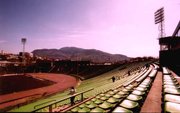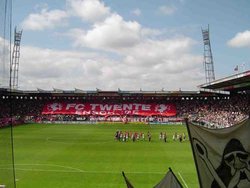Stadium
|
|
OlympiaStad1.gif
Olympic_Stadium_of_Athens.jpg
A modern stadium (plural stadiums, Latin plural stadia) is a place, or venue, for outdoor sports, concerts or other events, consisting of a field or stage partly or completely surrounded by a structure designed to allow spectators to stand or sit and view the event. Stadiums constructed primarily for viewing sporting events are often referred to as ballparks.
| Contents |
History of the stadium
The word originates from the Greek "stadion" (στάδιον), literally a (place where people) stand. The oldest known stadium is the one in Olympia, in western Peloponnese, Greece, where the Olympic Games of antiquity were held since 776 BC. Initially the Games consisted of a single event, a sprint along the length of the stadium. Therefore the length of the Olympia stadium was more or less standardized as a measure of distance (approximately 190 meters). The practice of standardizing footrace tracks to a length of 180-200 meters was followed by the Romans as well. Interestingly enough, a human's capacity to sustain maximum speed is known to diminish after about 200 meters of sprinting, a fact also seen in modern-day athletics. Greek and Roman stadia have been found in numerous ancient cities, perhaps the most famous being the Stadium of Domitian in Rome.
The modern stadium
Types
Domed stadiums have roofs. They are called stadiums because they are large enough for, and designed for what are generally considered to be outdoor sports. (Those designed for what are usually indoor sports are called arenas.) Some stadiums have partial roofs. Others have moveable roofs, and a few have even been designed to have moveable fields.
An all-seater stadium has seats for all spectators. Other stadiums are designed so that all or some spectators stand to view the event.
Design issues
Different sports require fields of different size and shape. Some stadiums are designed primarily for a single sport while other stadiums can accommodate different sports. Stadiums built specifically for some form of football are quite common. The most common multiple use design combines a football field with a running track, a combination which generally works fairly well, although certain compromises must be made. The major drawback is that the stands are necessarily set back a good distance from the field, especially at the ends of the field. In the case of some smaller stadiums, there aren't stands at the ends. When there are stands all the way around, the stadium takes on an oval shape. When one end is open, the stadium has a horseshoe shape. All three configurations (open, oval and horseshoe) are common, especially in the case of American college football stadiums.
In the United States, where baseball and American football are the two most popular outdoor spectator sports, a number of football/baseball multi-use stadiums were built beginning in the 1960s, and some of them were successful. However, since the requirements for baseball and football are significantly different, the trend beginning in the 1990s has been toward the construction of single-purpose stadiums. In several cases a football stadium has been constructed adjacent to a baseball park.
The spectator areas of a stadium are often referred to as terraces, especially in the United Kingdom but also in some American baseball parks, as an alternative to the term tier. Originally set out for standing room only, they are now usually equipped with seating. Either way, the term originates from the step-like rows which resemble agricultural terraces.
Related, but not precisely the same, is the use of terrace to describe a sloping portion of the outfield in a baseball park, possibly but not necessarily for seating, but for practical or decorative purposes. The most famous of these was at Crosley Field in Cincinnati, Ohio.
Corporate naming
In recent decades, the owners of sports stadiums in the United States found it worthwhile to subsidize costs by accepting corporate sponsorships. This trend, which began in the 1970s but accelerated greatly in the 1990s, has led to most stadium names being changed to that of the sponsor. The sponsorship phenomenon has since spread worldwide.
See also: Naming rights
See also
de:Stadion fr:Stade he:אצטדיון it:Stadio nl:Stadion pl:Stadion (obiekt sportowy) pt:Estádio ru:Стадион



